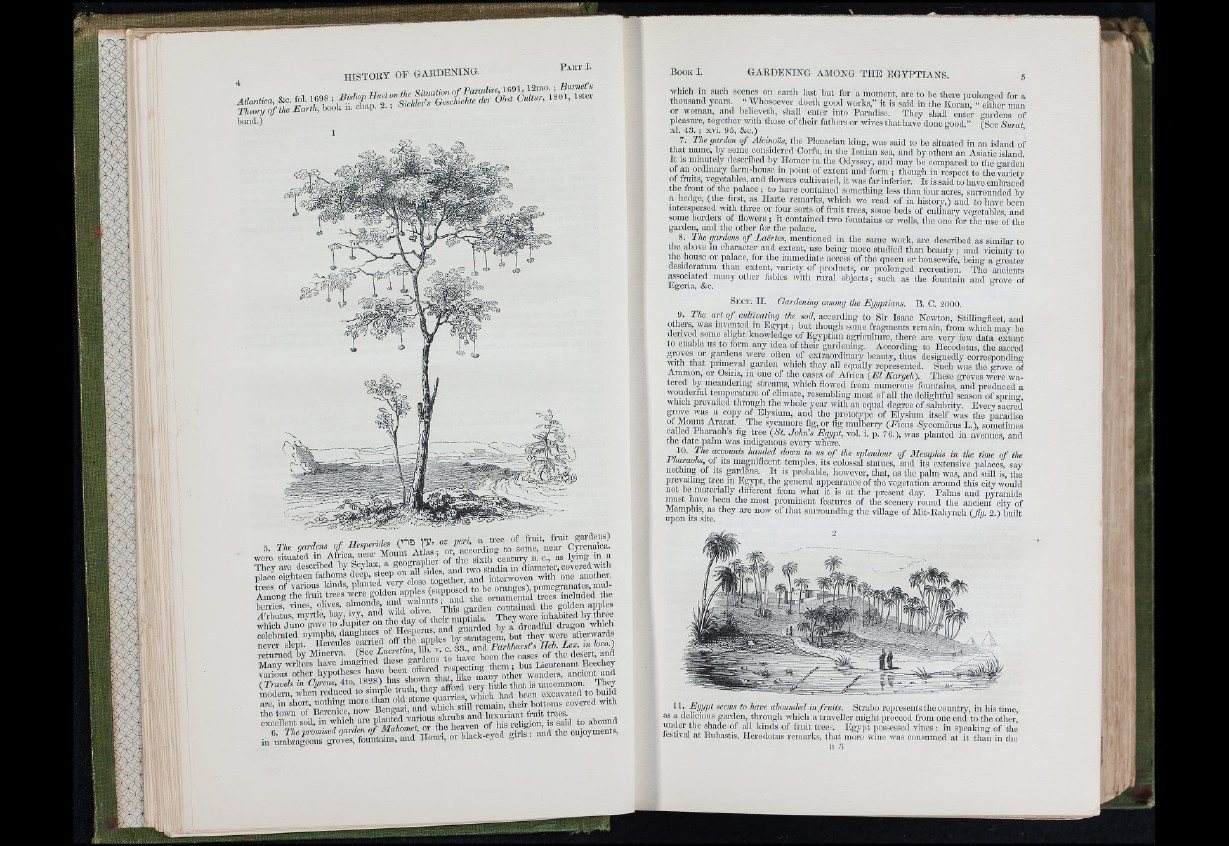
lir a p '
I t ' s •
IJs* ,
band.)
1
f t ¥ k
5. Tke gardens o f Heeperid^
were situated in Africa, near Mount ’ n f’tbe sixth century b. c., as lying in a
They are described by Scylax, a ^ ^ g^^dia in diameter, covered with
pH cL ig h tc™ fathoms
trees of various kinds, planted very z-,,™«,«,! to be oranges), pomegranates, mnl-
Among the fruit trees
berries, vines, obves, a t a o n ^ . ’t Ms garden contained the golden apples
A'rbutus, myitlo, bay, ivy, and wild °b™' . Ai i. They were inhabited by three
whieh Juno gave to Jupite r “ ^ i s » d S d by a dreadful dragon whieh
celebrated nymphs, fanghteis of Hrapeni , S ,,„ t they were afterwards
never slept. Hercules earned off he apples jj e i. Le:r. in hco.)
retm-ned by Mmciwa. C?®® , A' ' to h a re been the oases of the desert, and
Many writers have respecting them ; hut Eieutcnant Beechey
various other hypotheses have be many other wonders, ancient and
iT ra veb in Cyrene, « « - « 28) l i a ^ ^ ^ ^ oneommon. They
modem, when reduced to simple ,A „7 ^ ,,„m e s which had been excavated to build
are, in ™ ? Z l IZ o w B Z ig tri and which stiff remain, their bottoms covered with
I x i S s V in which are ^ " r t S e l v Z Z S to abound
i n '^ u m ^ I g C f Z o I Z f™^^ and the enjoyments.
which in such scenes on earth last but for a moment, are to be tliere prolonged for a
thousand years. “ Whosoever doetli good works,” it is said in the Koran, “ either man
or woman, and believeth, shall enter into I>aradise. They shall enter gai'dens of
pleasiu-e, together with those of their fathers or wives that have done good.” (See Surat,
xl. 43. ; xvi. 95, &c.) ’
7. The garden o f Alcinoiis, the Pheeacian king, was said to be situated in an island of
tliat name, by some considered Corfu, in the Ionian sea, and by others an Asiatic island.
It is minutely described by Homer in the Odyssey, and may be compared to the gai-den
ot an ordmaiy farm-house m point of extent and fom ; though in respect to the variety
ot fi-mts, vegetables, and flowers cultivated, it was ftir inferior. I t is said to have embraced
the front of the palace; to have contained something less than fom- acres, suiToundcd by
a Jiedge, (the first, as Hartc remarks, which wc read of in histoiy,) and to have been
interspersed with tlmee or foiu* sorts of fruit trees, some beds of culinary vegetables and
some bordci-s of flowers ; it contained two fountains or wells, the one for the use o fth e
garden, and the other for the palace.
8. The gardens o f Laertes, mentioned iu the same work, ai-e described as similar to
the above in character and extent, use being more studied than beauty ; and vicinity to
the house or palace, for the inmediate access o fth e queen or housewife, being a greater
desideratum than extent, variety of products, or prolonged recreation. The ancients
associated many other febles with iiiral objects; such as the fountain and grove of
Egena, &c. ^
S e c t . II. Gai-dening ainony the Egyptians. B . C. 2 0 0 0 .
9. The art o f cultivating the soil, according to Sir Isaac Newton, Stillingfleet, and
others, was invented in E g y p t; but though some fragments remain, from which may be
deiived some slight knowledge of Egj-ptian agriculture, there arc very few data extant
to enable us to form any idea of their gardening. According to Herodotus, the sacred
groves or gardens were often of extraordinary beauty, thus designedly coiTesponding
with that primeval garden which they all equally represented. Sucli was the grove of
Ammon, or Osms, in one of the oases of Africa {E l Kargeh). These groves were watered
by meandering streams, which flowed from numerous fountains, and produced a
wonderful temperature of climate, resembling most of all the delightful season of spring
which prevailed through the whole year with an equal degree of salubrity. Every sacred
grove was a copy of Elysium, and the prototype of Elysium itself was the pai-aclise
of Momit Arm-at. The sycamore fig, or fig mulbeiiy (Ficus jSycomonis L.), sometimes
called Pharaoh s fig tree { S t John’s Egypt, vol. i. p. 76.), was planted in avenues, and
the date palm was indigenous every where.
10. n e amounts handed down to us o f the splendour o f Memphis in the time o f the
rhaTaohs,ot its magnificent temples, its colossal statues, and its extensive palaces, say
nothing ot its gardens. I t is probable, however, that, as the palm was, and stiE is, the
prevailing tree in Egypt, the general appeai-auce of the vegetation ai-ound this city would
not be matenafiy different from what it is at the present day. Palms and pyramids
must have been the most prominent features of the scenery round the ancient city of
Memphis, as they ai-e now of that surrounding the village of Mit-Ralivneh upon Its site. ^ \(j f ivq . 2.j) built
1 1 . Egypt seems to have abounded in fruits. Strabo represents the country, in Ids time,
3 a delicious garden, through whicli a traveller might proceed from one end to the other,
u:nudd,eerr tthhee sshhaaddee ooff aallll kkiinnddss ooff ffmmiitt ttrreeeess.. EEggyypptt ppoosssseesssseedd vviinneess :: iinn ssppeeaakkiinngg ooff tthhee
icstival at Bubastis. Herodotus remarks, that more wine was consumed at it than in the
B 3